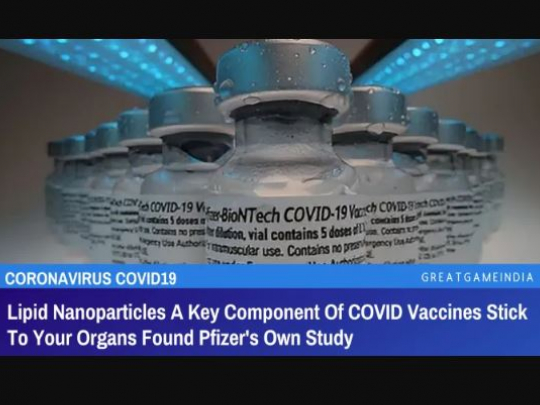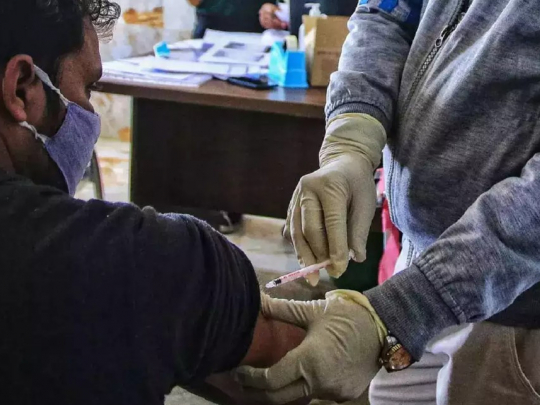Lipid Nanoparticles A Key Component Of COVID Vaccines Stick To Your Organs Found Pfizer’s Own Study

In information obtained through a Freedom of Information Act lawsuit filed by Judicial Watch, Pfizer’s own study revealed that lipid nanoparticles, a key component of their COVID vaccines, stick to your organs, especially the liver, adrenal glands, spleen, and ovaries
Judicial Watch today announced that it had received 466 pages of records (pdf below) from the Department of Health and Human Services (HHS) relating to biodistribution studies and related data for the COVID-19 vaccines, which show that lipid nanoparticles (LNPs), a key component of the vaccines developed by Pfizer/BioNTech, were found outside the injection site, primarily in the liver, adrenal glands, spleen, and ovaries of test animals, 8 to 48 hours after injection.
LNPs are used as a delivery mechanism in Pfizer/BioNTech’s mRNA-based COVID vaccine. Acuitas Therapeutics LNP technology is used in COMIRNATY, the Pfizer/BioNTech COVID-19 vaccine, according to a press release issued by Pfizer on January 10, 2022.
Johnson & Johnson relied on studies showing that vaccine DNA particles and injected virus particles were still present in test animals months after injection, according to 663 pages of records obtained from HHS regarding biodistribution studies and related data for COVID-19 vaccines, which show that Johnson & Johnson relied on studies showing that vaccine DNA particles and injected virus particles were still present in test animals months after injection.
According to the data, Johnson & Johnson did not include tests of the spike protein encoded in the J&J vaccination in its submission to the FDA for approval of its COVID vaccine.
A method of tracking where compounds of interest go in an experimental animal or human subject is called biodistribution.
The records were obtained through a Freedom of Information Act (FOIA) lawsuit (Judicial Watch v. U.S. Department of Health and Human Services (No. 1:21-cv-02418)) filed by Judicial Watch after the Food and Drug Administration, the Centers for Disease Control and Prevention, and the National Institute for Allergy and Infectious Disease failed to respond to a June 8, 2021, FOIA request for:
[A]ccess to biodistribution studies and related data for the Pfizer, Moderna, and Johnson & Johnson vaccines used to treat and/or prevent SARS-CoV-2 and/or COVID-19.
In a section titled “Safety Pharmacology,” the report notes, “No safety pharmacology studies were conducted with BNT162b2 [the BioNTech vaccine] as they are not considered necessary for the development of vaccines according to the WHO guideline (WHO, 2005).”
The Pfizer records also include a report approved in February 2021 on the animal trials on the distribution of the Pfizer COVID vaccine in rat subjects. “Nonclinical studies evaluating pharmacodynamic drug interactions with BNT162b2 were not conducted as they are generally not considered necessary to support the development and licensure of vaccine products for infectious diseases (WHO, 2005),” it says under “Pharmacodynamic Drug Interactions.”
When lipid nanoparticles (LNPs) “with a comparable composition” to those used in in the Pfizer COVID vaccine were injected into rats, “total recovery (% of injected dose) of LNP outside the injection site was greatest in the liver and was much less in the spleen, adrenal glands, and ovaries,” according to this Pfizer report.
“In summary” … “the LNP distributes to the liver .” “Over 48 hours, the LNP distributed mainly to liver, adrenal glands, spleen and ovaries, with maximum concentrations observed at 8-48 hours post-dose,” the research stated in its extensive analysis.”” Total recovery (% of injected dose) of LNP, for combined male and female animals, outside of the injection site was greatest in the liver (up to 18%) …”
“No genotoxicity studies are planned for BNT162b2 [the Pfizer/BioNTech COVID vaccine] as the components of the vaccine constructs are lipids and RNA and are not expected to have genotoxic potential (WHO, 2005),” according to the same Pfizer/BioNTech study. Similarly, “Carcinogenicity studies with BNT162b2 have not been conducted as the components of the vaccine construct are lipids and RNA and are not expected to have carcinogenic or tumorigenic potential.”
“The nonclinical program demonstrates that BNT162b2 is immunogenic in mice, rats, and nonhuman primates, and the toxicity studies support the licensure of this vaccine,” says the study’s conclusion. “Boost immunizations” were also tested on the animals in the trial, according to the report. “Vaccine-related microscopic findings at the end of dosing for BNT162b2 were evident in injection sites and surrounding tissues, in the draining iliac lymph nodes, bone marrow, spleen, and liver,” the researchers added.
A report titled “Pharmacokinetics Tabulated Summary,” which was approved in January 2021, is also contained in the Pfizer report. The biodistribution of lipid nanoparticles containing mRNA employed in the vaccination employing rats as clinical trial participants is shown in a table in the study, with LNPs accumulating after 48 hours, particularly in lymph nodes, ovaries, small intestine, and spleen.
“Justification for the absence of studies in CTD Module 4 (part of 2.4),” a September 2020 “Confidential” appendix to the clinical trial studies submitted for the Pfizer/BioNTech COVID vaccine (BNT162b2), notes under “Safety Pharmacology” that “No safety pharmacology studies were conducted as they are not considered necessary according to the WHO guideline (WHO, 2005).”
“Nonclinical studies evaluating pharmacodynamic drug interactions were not conducted as they are not generally considered necessary to support development and licensure of vaccine products for infectious diseases (WHO, 2005),” it says under “Pharmacodynamic Drug Interactions.”
Pfizer investigated a vaccine with an RNA strand “that self-amplifies upon entering the cell” in a “Confidential” study approved in April 2020 that looked at four COVID vaccine variations. It “encodes the Venezuelan equine encephalitis (VEE) virus RNA-dependent RNA polymerase (RDRP or replicase).”
“Although liver function tests will be carefully monitored during the clinical development of these vaccines, BioNTech’s prior clinical experience indicates that distribution to the liver does not pose a safety concern,” the authors write in the same Pfizer paper.
The Johnson & Johnson COVID-19 vaccines’ “Pharmacokinetics Written Summary” from June 2020 states:
Ad26COVS1 (also known as VAC31518 or JNJ-78436735) is a monovalent, recombinant replication-incompetent adenovirus type 26 (Ad26) vectored vaccine encoding a severe acute respiratory syndrome coronavirus 2 (SARS-CoV-2) Spike protein…. No specific pharmacokinetic studies have been performed with Ad26COVS1.
However, to assess distribution, persistence, and clearance of the Ad26 vector (platform), biodistribution studies were conducted in rabbits using two other Ad26-based vaccines encoding [redacted] and [redacted] antigens…. [T]he available biodistribution results are considered sufficient to inform on the biodistribution profile of Ad26COVS1, for which the same Ad26 vector backbone is used.
“These documents show why many Americans have concerns about whether the novel COVID vaccines that were developed at such an accelerated pace were tested properly and thoroughly,” said Tom Fitton, president of Judicial Watch.
- Source : GreatGameIndia


















